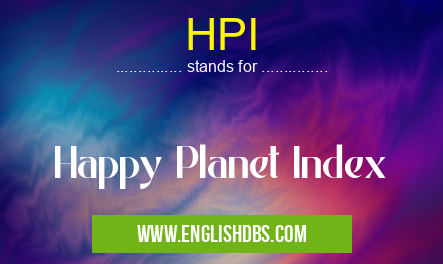What does HPI mean in ENVIRONMENTAL
The Happy Planet Index, abbreviated as HPI, is a comprehensive measure that gauges the efficiency of nations in promoting the happiness and well-being of their citizens while minimizing their ecological footprint. Developed by the New Economics Foundation, the HPI serves as a valuable tool for policymakers and stakeholders to assess the overall well-being and sustainability of countries.

HPI meaning in Environmental in Governmental
HPI mostly used in an acronym Environmental in Category Governmental that means Happy Planet Index
Shorthand: HPI,
Full Form: Happy Planet Index
For more information of "Happy Planet Index", see the section below.
What does HPI stand for?
HPI stands for:
- Happy Planet Index
HPI Meaning in Governmental
In the context of governance, the HPI plays a crucial role in setting policy agendas and evaluating the effectiveness of government initiatives. By providing a holistic measure of happiness, well-being, and environmental sustainability, the HPI empowers policymakers to prioritize policies that enhance the quality of life for citizens while preserving natural resources.
Key Features of the HPI
- Life expectancy: Measures the average number of years a person is expected to live in good health.
- Well-being: Assesses psychological well-being, including factors such as life satisfaction, positive emotions, and autonomy.
- Ecological footprint: Calculates the land and water area required to sustain a population's consumption and waste generation.
HPI Formula
The HPI is calculated using the following formula:
HPI = Life Expectancy * Well-being / Ecological FootprintEssential Questions and Answers on Happy Planet Index in "GOVERNMENTAL»ENVIRONMENTAL"
What is the Happy Planet Index (HPI)?
The HPI is a metric that measures the well-being and sustainability of countries worldwide. It combines three main indicators: life expectancy, happiness, and ecological footprint.
How is the HPI calculated?
The HPI is calculated by multiplying life expectancy by life satisfaction (adjusted for inequality) and dividing the result by ecological footprint.
What do the different components of the HPI represent?
Life Expectancy: Measures the average number of years a person is expected to live. Life Satisfaction: Measures how happy and satisfied people are with their lives. Ecological Footprint:** Measures the amount of natural resources required to sustain a population's consumption.
What countries have the highest and lowest HPI scores?
In recent years, Costa Rica, Finland, and Denmark have consistently ranked among the top countries with the highest HPI scores. Countries with lower scores, such as Afghanistan, Chad, and Yemen, face significant challenges in terms of well-being and sustainability.
What are the benefits of using the HPI?
The HPI provides a comprehensive measure of countries' progress towards sustainable development. It helps policymakers and organizations identify areas where improvements can be made, promotes a focus on both well-being and environmental sustainability, and encourages a holistic approach to development.
What are the limitations of the HPI?
The HPI is based on available data, which may vary in quality and availability across countries. It does not capture all aspects of well-being and sustainability, and the weighting of the different components can influence the results.
Final Words: The Happy Planet Index provides a valuable framework for assessing the progress and well-being of nations by incorporating both happiness and sustainability into a single metric. It serves as a crucial tool for policymakers, researchers, and civil society organizations in devising and evaluating policies that promote both human happiness and environmental health.
HPI also stands for: |
|
| All stands for HPI |
